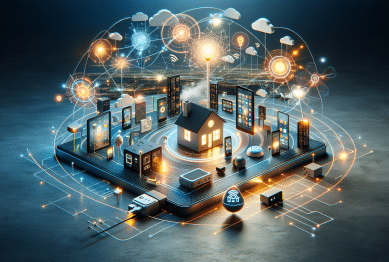Uncover the fascinating ways artificial intelligence is revolutionizing smart homes. This guide reveals essential information about the latest AI-driven features, integration tips, privacy issues, and the real impact on daily living. Explore how connected technology shapes the future of living spaces.
The Rise of Artificial Intelligence in Home Technology
Artificial intelligence is steadily reshaping daily life, and nowhere is this more apparent than with smart home innovations. By embedding learning algorithms into household devices, smart homes become more responsive, adaptive, and intuitive. Lighting, security, temperature, and even kitchen appliances are increasingly powered by AI-enabled systems designed to learn your preferences and routines. This integration results in spaces that feel personalized and efficient, offering users enhanced convenience and safety. The growing ecosystem also motivates rapid development, with tech companies investing heavily in devices that interact seamlessly through platforms like Google Assistant or Amazon Alexa. As these technologies evolve, everyday living continues to shift toward automation and intelligent control, shaping experiences that were once the stuff of science fiction.
AI-powered smart homes are not just about convenience. They transform energy management and cost efficiency as well. Machine learning algorithms track usage patterns in real time—adjusting lighting, heating, and cooling to minimize waste and lower utility bills. Even home security systems now leverage AI to spot unusual activity, send timely alerts, and coordinate with smart locks for added peace of mind. This proactive approach benefits users by streamlining daily routines and reducing manual intervention. As the smart home market expands, competition fuels innovation, ensuring new solutions constantly emerge.
Smart homes fueled by artificial intelligence don’t operate in silos. They’re increasingly interconnected through the Internet of Things (IoT), where sensors and devices exchange data for better decision-making. Whether orchestrating entertainment with voice commands or scheduling chores using a smart assistant, you can enjoy a living environment that adapts to your needs. The accelerating adoption rate underscores the growing trust in these systems, even as discussions about data privacy and security gain prominence. Staying informed is essential as living spaces become ever more dynamic and responsive.
Key AI Features Transforming Modern Living Spaces
Today’s smart homes offer impressive features powered by AI. Voice recognition assistants streamline tasks—from adjusting lighting to playing music—through natural language interaction. These systems learn your preferences, enabling contextual suggestions that fit your lifestyle habits. Predictive maintenance is another vital area, where AI identifies appliance anomalies and suggests fixes before issues escalate. This not only protects investments in home technology but also saves time and minimizes disruptions.
AI-driven security systems are gaining serious attention. Modern cameras analyze footage in real-time, distinguishing between familiar occupants and unexpected movement, reducing false alarms. Some even integrate facial recognition for personalized notifications. Coupled with smart locks and doorbell cameras, this tech delivers a multi-layered approach to security that feels both intuitive and reliable. Data encryption and two-factor authorization help further shield sensitive information, balancing convenience with vigilance (Source: https://www.energy.gov/articles/how-artificial-intelligence-transforming-smart-homes).
Another rising trend is smart energy management. AI systems can optimize appliance use based on occupancy and anticipated weather patterns, shifting heavy loads to off-peak hours to save money. Some platforms even provide detailed analytics, allowing homeowners to track usage and set carbon-reduction goals. This benefit extends to integration with solar panels, EV charging stations, and advanced thermostats for maximum efficiency and minimal carbon footprints. AI’s adaptability ensures features continuously evolve as more user data becomes available.
Integrating AI into Your Home: What to Know
Setting up an AI-powered smart home begins with planning. Deciding which devices to include—and whether to build around a singular ecosystem like Apple HomeKit or Google Home—can affect compatibility and future upgrades. Many recommend starting with foundational pieces: smart thermostats, lighting, and a robust home assistant. These lay the groundwork for further expansion and simplify control over disparate systems.
While modern smart home devices boast plug-and-play deployment, secure Wi-Fi networks are critical. AI systems depend on constant connectivity to perform at their peak. Routine software updates from reputable manufacturers are also necessary, as they patch vulnerabilities and introduce new AI features. Opt for devices with strong encryption and privacy controls to ensure safe automation (Source: https://www.nist.gov/blogs/taking-measure/smart-homes-better-life-and-safer-too).
Personalization is the true advantage of AI-powered homes. Take time to customize routines—such as morning lighting, security settings, or scheduled cleaning robots—so your space truly adapts. Many platforms allow rule-based automation: lights off when you leave, or adjusting temperatures according to individual preferences. Explore integrations that fit your lifestyle and offer transparent opt-out options for data sharing, ensuring technology supports rather than controls home life.
Personalization and Daily Impact of AI Automation
Personalization extends far beyond simple device control. AI can learn routines, adapt to shifting schedules, and even anticipate needs you may not express aloud. For example, a smart coffee machine could have your preferred drink ready when morning alarms go off, or adjust temperature settings automatically when your calendar signals you’re working late. This intuitive adaptation creates a sense of seamless comfort and can help reduce cognitive load during busy days.
Adaptive entertainment systems represent another leap forward. AI provides personalized music, news, or video recommendations based on your preferences and activities. Sounds adjust to match contexts—energetic playlists for cleaning, calming melodies for unwinding in the evening. In some homes, AI even organizes grocery orders by tracking consumption patterns, ensuring essentials are always stocked. The sum effect: daily life becomes smoother and more enjoyable, while freeing up mental energy for what matters most.
Voice and gesture control are quickly becoming a standard, enabling hands-free management of lights, appliances, or even appliances like ovens. For those with limited mobility, smart homes equipped with AI-driven controls provide invaluable independence and accessibility. This benefit is often cited as a life-changing feature, particularly for seniors or individuals with disabilities (Source: https://www.nia.nih.gov/news/smart-homes-improve-independence-older-adults). Thoughtful setup allows the technology to fade into the background, supporting daily rituals in subtle, supportive ways.
Balancing Security, Privacy, and Convenience
With all their benefits, AI-powered systems require careful attention to privacy and security. Since these devices constantly collect and analyze user data, safeguarding information is paramount. Multi-level encryption and biometric authentication, such as fingerprint or face recognition, are essential best practices. Additionally, many companies now provide transparency reports outlining exactly what data is gathered and how it’s stored.
Industry standards often guide the secure deployment of smart home technology. The National Institute of Standards and Technology (NIST) advises using unique passwords, enabling automatic device updates, and disconnecting unused devices to limit digital exposure (Source: https://www.consumer.ftc.gov/articles/connected-homes-smart-choices). Reading privacy policies before enabling any voice or video feature—no matter how convenient—builds confidence and reduces the risk of unwanted data tracking.
Ultimately, the convenience of AI-enabled homes hinges on a foundation of trust. Homeowners benefit by routinely resetting passwords and limiting location sharing. For families, educating all members about safe device use is just as important as initial installation. The balance between innovation and privacy is dynamic, but manageable. Staying informed about current guidelines will help maintain both smoother operations and peace of mind.
Looking Ahead: The Future of AI in Home Life
Artificial intelligence is nowhere near its limits. Future upgrades may include more conversational home assistants, improved emotional recognition, and deeper integration with wearable technology. Research efforts are pushing boundaries in machine learning, aiming for intuitive homes that can, for example, distinguish between different family members and offer tailored suggestions throughout the day. The goal is to make technology invisible—always present, but never intrusive.
Upcoming innovations may focus on sustainability, allowing AI to manage energy not just at the home level but across neighborhoods, helping entire communities reduce their carbon impact (Source: https://northwestern.edu/magazine/winter2020/feature/smart-homes.html). IoT and AI will continue their convergence, creating new possibilities for connected healthcare, personal safety, and entertainment. While the foundation is already impressive, there is still endless room for new features and improvements as computing power grows.
Public policy and ethical standards will play an ever-increasing role. Transparent data practices, fair AI algorithms, and accessibility features must evolve in tandem with technology. As consumer groups, government agencies, and independent auditors contribute to oversight, future smart homes will become safer and even smarter. Those considering upgrades or new builds may want to monitor these trends for both capability and compliance. Adaptation is inevitable, but thoughtful planning ensures a positive, empowering experience for all.
References
1. U.S. Department of Energy. (n.d.). How Artificial Intelligence Is Transforming Smart Homes. Retrieved from https://www.energy.gov/articles/how-artificial-intelligence-transforming-smart-homes
2. National Institute of Standards and Technology. (n.d.). Smart Homes for a Better Life—and Safer, Too. Retrieved from https://www.nist.gov/blogs/taking-measure/smart-homes-better-life-and-safer-too
3. National Institute on Aging. (n.d.). Smart Homes Improve Independence for Older Adults. Retrieved from https://www.nia.nih.gov/news/smart-homes-improve-independence-older-adults
4. Federal Trade Commission. (n.d.). Connected Homes, Smart Choices. Retrieved from https://www.consumer.ftc.gov/articles/connected-homes-smart-choices
5. Northwestern University. (n.d.). Are Smart Homes Getting Too Smart? Retrieved from https://northwestern.edu/magazine/winter2020/feature/smart-homes.html
6. Pew Research Center. (n.d.). The Internet of Things Connectivity Binge: What Are the Implications? Retrieved from https://www.pewresearch.org/internet/2017/06/06/the-internet-of-things-connectivity-binge-what-are-the-implications/









